Atomistic Construction of Silicon Nitride Ceramic Fiber Molecular Model and Investigation of Its Mechanical Properties Based on Molecular Dynamics Simulations
Abstract
:1. Introduction
- Diversity and complexity of structure: Amorphous structures lack regularity and periodicity, leading to high diversity and complexity in their short-range atomic arrangements. As a result, studying amorphous structures often requires a combination of various methods and techniques to describe and characterize their structural features.
- Nonperiodicity and locality: Unlike crystalline structures, amorphous structures are nonperiodic, making it challenging to use traditional crystallographic methods for analysis and characterization. Additionally, amorphous structures typically exhibit locality, meaning structural features present nonuniform distribution in space, making accurate description and quantification more difficult.
- Lack of structural descriptors: Due to the diversity and complexity of amorphous structures, it is often challenging to describe them using simple structural models and crystallographic parameters.
- Experimental technique limitations: Conventional structural characterization techniques such as X-ray diffraction and electron diffraction often have limited capabilities for analyzing amorphous structures. Moreover, amorphous structures often display a wide range of structural scales and irregularities, which exceed the resolution range of traditional techniques.
2. Experimental
2.1. Materials and Preparation
2.2. Measurements
3. Results and Discussion
3.1. Structural Characterization and Molecular Dynamics Model Construction of Silicon Nitride Fiber
3.1.1. Construction Algorithm of Amorphous Silicon Nitride Ceramic Fiber Model
- Mixed structure with non-crosslinked interfaces: This model comprises Si and N elements forming short-range ordered and irregular structures based on Si-N bonds, where Si atoms are hybridized in SP3 and N atoms in SP2.
- Mixed structure with crosslinked interfaces: This model consists of Si and N elements, with some regions existing in the form of α-Si3N4 crystallites surrounded by continuous amorphous Si-N structures. A crosslinking algorithm was applied to bond connectable atoms within 2 Å of any atom in the crystallite, constructing a continuous interface between the two phases.
- Model with amorphous structure: This model is composed of Si and N elements, with some regions existing in the form of α-Si3N4 crystallites surrounded by continuous amorphous Si-N structures. The amorphous atoms within 2 Å of any atom in the crystallite were removed to ensure phase discontinuity.
- ;
- Velocity of the atoms;
- Atomic distance between and ;
- Atomic force between and Volume of atom .
3.1.2. Construction Algorithm of Molecular Model Construction of Amorphous and Crystal Structure Transition Interface
- Determine the models for the crystal and amorphous materials: Select appropriate structures for both the crystal and amorphous materials. In this study, the crystal structure chosen is α-Si3N4.
- Identify the interface region: Define the contact interface region between the crystal and amorphous materials, as this is the main focus of the transition structure. In this study, the spatial region within 20 Å above the interface is considered the primary bonding region, while the preexisting crystal structure is set to be nonbonding.
- Generate the interface atom structure: Within the interface region, utilize the previously described crosslinking procedure to construct a crosslinking reaction model. Apply a criterion for bond formation and cancel bonding when the bonding atoms are beyond 20 Å from the interface and vice versa.
- Energy minimization and structure optimization: Perform energy minimization and structure optimization on the generated interface atom structure to achieve a relatively stable state. This step helps eliminate any unreasonable structures and brings the interface atom structure closer to actual physical phenomena.
3.1.3. Construction Algorithm of Molecular Model Construction of Amorphous and Crystal Structure Transition Interface
- Determine the models for the crystal and amorphous materials: Select appropriate structures for both the crystal and amorphous materials. In this study, the crystal structure chosen is α-Si3N4.
- Identify the interface region: Define the contact interface region between the crystal and amorphous materials, as this is the main focus of the transition structure. In this study, the spatial region within 20 Å above the interface is considered the primary bonding region, while the preexisting crystal structure is set to be nonbonding.
- Generate the interface atom structure: Within the interface region, utilize the previously described crosslinking procedure to construct a crosslinking reaction model. Apply a criterion for bond formation and cancel bonding when the bonding atoms are beyond 20 Å from the interface and vice versa.
- Energy minimization and structure optimization: Perform energy minimization and structure optimization on the generated interface atom structure to achieve a relatively stable state. This step helps eliminate any unreasonable structures and brings the interface atom structure closer to actual physical phenomena.
3.2. Microstructure and Mechanical Properties of Amorphous and Crystal Transition Structure
3.3. Study on Mechanical Properties of Molecular Model of Silicon Nitride Ceramic Fiber
3.3.1. Stress–Strain Curve
- Elastic region: In the initial stage of tension, the model experiences elastic deformation, and the relative positions of the molecules remain stable. External loading induces relative atomic displacement, but the atomic arrangement remains unchanged, showing linear elastic behavior.
- Plastic region: As the external stress continues to increase, the model enters the plastic deformation stage. In this stage, relative atomic positions undergo slip, diffusion, and rearrangement. Some stress concentration regions experience Si-N bond breakage to accommodate the increasing load. The changes during this stage are irreversible.
- Failure region: When the stress in a localized area reaches the model’s fracture strength, stress concentration leads to the formation of fracture surfaces, large-scale rupture of atomic chemical bonds, and the initiation of cracks and fracture surfaces, resulting in material failure.
3.3.2. Tensile Fracture Property
3.3.3. Free Volume and Fracture Behavior
- Elastic stage: In the initial stage of tensile loading, the material exhibits elastic deformation, with relatively stable molecular positions and minimal changes in free volume. Although external stress causes molecular displacement and strain, the overall arrangement and gaps between molecules remain largely unchanged.
- Plastic deformation stage: As external stress increases, the material enters the plastic deformation stage. Here, molecular sliding, diffusion, and rearrangement occur to accommodate the rising stress and localized displacement. These plastic deformation processes may cause relative molecular displacement and reorganization, resulting in changes to the free volume.
- Fracture stage: Fracture occurs when the material reaches its breaking point. In this stage, the free volume significantly increases as molecular bonds are broken, fracture surfaces form, and previously constrained molecules regain more free space.
4. Conclusions
Author Contributions
Funding
Institutional Review Board Statement
Informed Consent Statement
Data Availability Statement
Conflicts of Interest
References
- Minasyan, T.; Liu, L.; Aghayan, M.; Rodriguez, M.A.; Aydinyan, S.; Hussainova, I. Mesoporous fibrous silicon nitride by catalytic nitridation of silicon. Prog. Nat. Sci. Mater. Int. 2019, 29, 190–197. [Google Scholar] [CrossRef]
- Hu, X.; Shao, C.; Wang, J.; Wang, H. Characterization and high-temperature degradation mechanism of continuous silicon nitride fibers. J. Mater. Sci. 2017, 52, 7555–7566. [Google Scholar] [CrossRef]
- Guan, J.; Wang, Y.; Cheng, L.; Xie, Y.; Zhang, L. Fabrication and characterization of short silicon nitride fibers from direct nitridation of ferrosilicon in N2 atmosphere. Materials 2018, 11, 2003. [Google Scholar] [CrossRef]
- Zhang, J.; Zhang, J.; Mei, S.; Zhou, J.; Liu, X.; Wang, C.; Cao, S.; Zhang, D. Degradation behavior of amorphous silicon nitride fibers in low atmospheric pressure. J. Mater. Sci. 2021, 56, 13964–13974. [Google Scholar] [CrossRef]
- Sun, X.; Liu, H.T.; Cheng, H.F. Oxidation behavior of silicon nitride fibers obtained from polycarbosilane fibers via electron beam irradiation curing. RSC Adv. 2017, 7, 47833–47839. [Google Scholar] [CrossRef]
- Chen, S.; Chen, C.; Liang, X.; Wu, C.; Ji, J.; Xu, M.; Zhang, Z.; Huang, Z. Effect of cellulose additive on the silicon carbide film by decomposition and conversion of silicon nitride. Ceram. Int. 2020, 46, 8130–8134. [Google Scholar] [CrossRef]
- Hu, X.; Shao, C.; Wang, J.; Wang, H.; Cheng, J. Effects of residual radicals on compositional and structural stability of silicon nitride fibers. J. Eur. Ceram. Soc. 2017, 37, 4497–4503. [Google Scholar] [CrossRef]
- Zhang, S.; Hua, Y.; Wang, Q.; Zhang, G.; Lei, H.; Yu, Z.; Li, S.; Chen, L. Effects of oxygen on the thermal stability of silicon nitride fibers. J. Eur. Ceram. Soc. 2022, 42, 2691–2698. [Google Scholar] [CrossRef]
- Ye, C.C.; Ru, H.Q.; Chen, D.L. Fatigue behavior of silicon nitride ceramics. Ceram. Int. 2023, 49, 28405–28414. [Google Scholar] [CrossRef]
- Heimann, R.B. Silicon nitride ceramics: Structure, synthesis, properties, and biomedical applications. Materials 2023, 16, 5142. [Google Scholar] [CrossRef] [PubMed]
- Hu, X.; Shao, C.; Wang, J. Surface defect healing effect of silica coatings on silicon nitride fibers. Ceram. Int. 2017, 43, 16703–16709. [Google Scholar] [CrossRef]
- Logesh, G.; Rashad, M.; Lodhe, M.; Sabu, U.; Joseph, A.; James Raju, K.C.; Balasubramanian, M. Mechanical and dielectric properties of carbon fiber reinforced reaction bonded silicon nitride composites. J. Alloys Compd. 2018, 767, 1083–1093. [Google Scholar] [CrossRef]
- Baba, S.; Goto, T.; Cho, S.H.; Sekino, T. Effect of nitrogen gas pressure during heat treatment on the morphology of silicon nitride fibers synthesized by carbothermal nitridation. J. Asian Ceram. Soc. 2018, 6, 401–408. [Google Scholar] [CrossRef]
- Zhang, J.; Fan, J.; Zhang, J.; Zhou, J.; Liu, X.; Qie, D.; Zhang, D. Developing and preparing interfacial coatings for high tensile strength silicon nitride fiber reinforced silica matrix composites. Ceram. Int. 2018, 44, 5297–5303. [Google Scholar] [CrossRef]
- Logesh, G.; Lodhe, M.; Balasubramanian, M. Effect of temperature and gaseous medium on the evolved microstructures of carbon fiber reinforced reaction bonded silicon nitride composites. Ceram. Int. 2017, 43, 6110–6116. [Google Scholar] [CrossRef]
- Yao, J.; Wu, Y.; Sun, J.; Xu, Y.; Wang, H.; Zhou, P. Research on the metamorphic layer of silicon nitride ceramic under high temperature based on molecular dynamics. Int. J. Adv. Manuf. Technol. 2020, 109, 1249–1260. [Google Scholar] [CrossRef]
- Zhou, Y.; Yang, W.; Hu, M.; Yang, Z. The typical manners of dynamic crack propagation along the metal/ceramics interfaces: A molecular dynamics study. Comput. Mater. Sci. 2016, 112, 27–33. [Google Scholar] [CrossRef]
- Li, S.J.; Qian, H.J.; Lu, Z.Y. A simulation study on the glass transition behavior and relevant segmental dynamics in free-standing polymer nanocomposite films. Soft Matter 2019, 15, 4476–4485. [Google Scholar] [CrossRef]
- Zhang, M.; Liao, N.; Xue, W.; Yang, P. Large-scale molecular dynamics modeling of boron-doped amorphous SiCO ceramics. J. Mol. Model 2017, 23, 178. [Google Scholar] [CrossRef] [PubMed]
- Daneshian, B.; Gärtner, F.; Assadi, H.; Vidaller, M.V.; Höche, D.; Klassen, T. Features of ceramic nanoparticle deformation in aerosol deposition explored by molecular dynamics simulation. Surf. Coat. Technol. 2022, 429, 127886. [Google Scholar] [CrossRef]
- Liang, B.; Yang, Z.-H.; Jia, D.-C.; Rao, J.-C.; Yu, D.-L.; Tian, Y.-J.; Li, Q.; Miao, Y.; Zhu, Q.-S.; Zhou, Y. Amorphous silicoboron carbonitride monoliths resistant to flowing air up to 1800 °C. Corros. Sci. 2016, 109, 162–173. [Google Scholar] [CrossRef]
- Chai, Z.; Ding, J.; Deng, C.; Zhu, H.; Li, G.; Yu, C. Ni-catalyzed synthesis of hexagonal plate-like alpha silicon nitride from nitridation of Si powder in molten salt media. Adv. Powder Technol. 2016, 27, 1637–1644. [Google Scholar] [CrossRef]
- Du, Y.; Luo, Z.; Yang, Y.; Yang, Y.; Yuan, W.; Li, H.; Hong, Y.; Dai, Z.; Zhang, P.; Zhao, T. Theoretical and experimental investigations into the pyrolysis mechanisms of silicon-modified phenolic resin under high temperatures. Carbon 2023, 201, 504–519. [Google Scholar] [CrossRef]
- Durandurdu, M. Ab initio simulation of amorphous BC3. Comput. Mater. Sci. 2020, 178, 109622. [Google Scholar] [CrossRef]
- Lee, J.; Mangalara, J.H.; Simmons, D.S. Correspondence between the rigid amorphous fraction and nanoconfinement effects on glass formation. J. Polym. Sci. Part B Polym. Phys. 2017, 55, 907–918. [Google Scholar] [CrossRef]
- Higuchi, Y.; Kubo, M. Deformation and fracture processes of a lamellar structure in polyethylene at the molecular level by a coarse-grained molecular dynamics simulation. Macromolecules 2017, 50, 3690–3702. [Google Scholar] [CrossRef]
- Olsson, P.A.T.; Andreasson, E.; Bergvall, E.; Jutemar, E.P.; Petersson, V.; Rutledge, G.C.; Kroon, M. All-atomic and coarse-grained molecular dynamics investigation of deformation in semi-crystalline lamellar polyethylene. Polymer 2018, 153, 305–316. [Google Scholar] [CrossRef]
- Pervaje, A.K.; Pasquinelli, M.A.; Khan, S.A.; Santiso, E.E. Multiscale constitutive modeling of the mechanical properties of polypropylene fibers from molecular simulation data. Macromolecules 2022, 55, 728–744. [Google Scholar] [CrossRef]
- Lu, X.; Yang, P.; Luo, J.; Ren, J.; Xue, H.; Ding, Y. Tensile mechanical performance of Ni-Co alloy nanowires by molecular dynamics simulation. RSC Adv. 2019, 9, 25817–25828. [Google Scholar] [CrossRef]
- Gunkelmann, N.; Bringa, E.M.; Rosandi, Y. Molecular dynamics simulations of aluminum foams under tension: Influence of oxidation. J. Phys. Chem. C 2018, 122, 26243–26250. [Google Scholar] [CrossRef]
- Li, P.-t.; Yang, Y.-Q.; Xia, Z.; Luo, X.; Jin, N.; Gao, Y.; Liu, G. Molecular dynamic simulation of nanocrystal formation and tensile deformation of TiAl alloy. RSC Adv. 2017, 7, 48315–48323. [Google Scholar] [CrossRef]
- Ebrahem, F.; Stratmann, J.; Stoffel, M.; Markert, B.; Bamer, F. Continuous zachariasen carbon monolayers under tensile deformation: Insights from molecular dynamics simulations. Extrem. Mech. Lett. 2020, 38, 100744. [Google Scholar] [CrossRef]
- Nie, C.; Peng, F.; Xu, T.; Ding, Y.; Sheng, J.; Chen, W.; Li, L. Biaxial stretch-induced crystallization of polymers: A molecular dynamics simulation study. Macromolecules 2021, 54, 9794–9803. [Google Scholar] [CrossRef]
- Jiang, K.; Yan, Z.; Fang, W.; Zhang, Y.; Wang, Z. Molecular dynamics simulation on tensile behavior of cellulose at different strain rates. Adv. Mater. Sci. Eng. 2023, 2023, 7890912. [Google Scholar] [CrossRef]
- Wang, P.; Li, H.; Yang, L. Free volume contributing to the different yield behaviors between tension and compression deformations in metallic glasses. Metals 2017, 7, 444. [Google Scholar] [CrossRef]
- Da, W.; Wang, P.W.; Wang, Y.F.; Li, M.F.; Yang, L. Inhomogeneity of free volumes in metallic glasses under tension. Materials 2018, 12, 98. [Google Scholar] [CrossRef]
- Katakam, K.C.; Yedla, N. Tensile and creep behavior of nickel nanowires containing volume defects: Insight into the deformation mechanisms and microstructural evolution using molecular dynamics simulations. Mater. Chem. Phys. 2022, 277, 125560. [Google Scholar] [CrossRef]
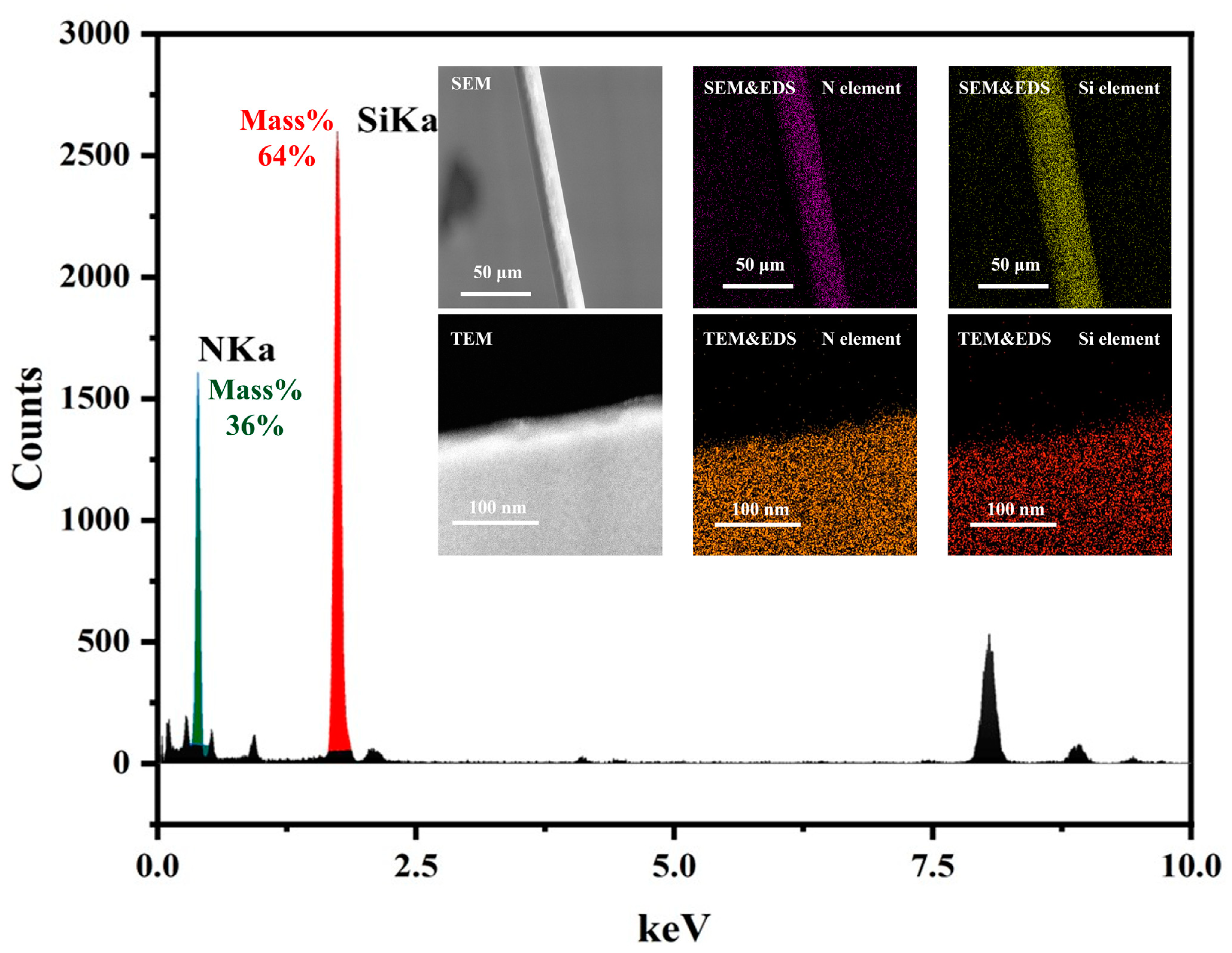

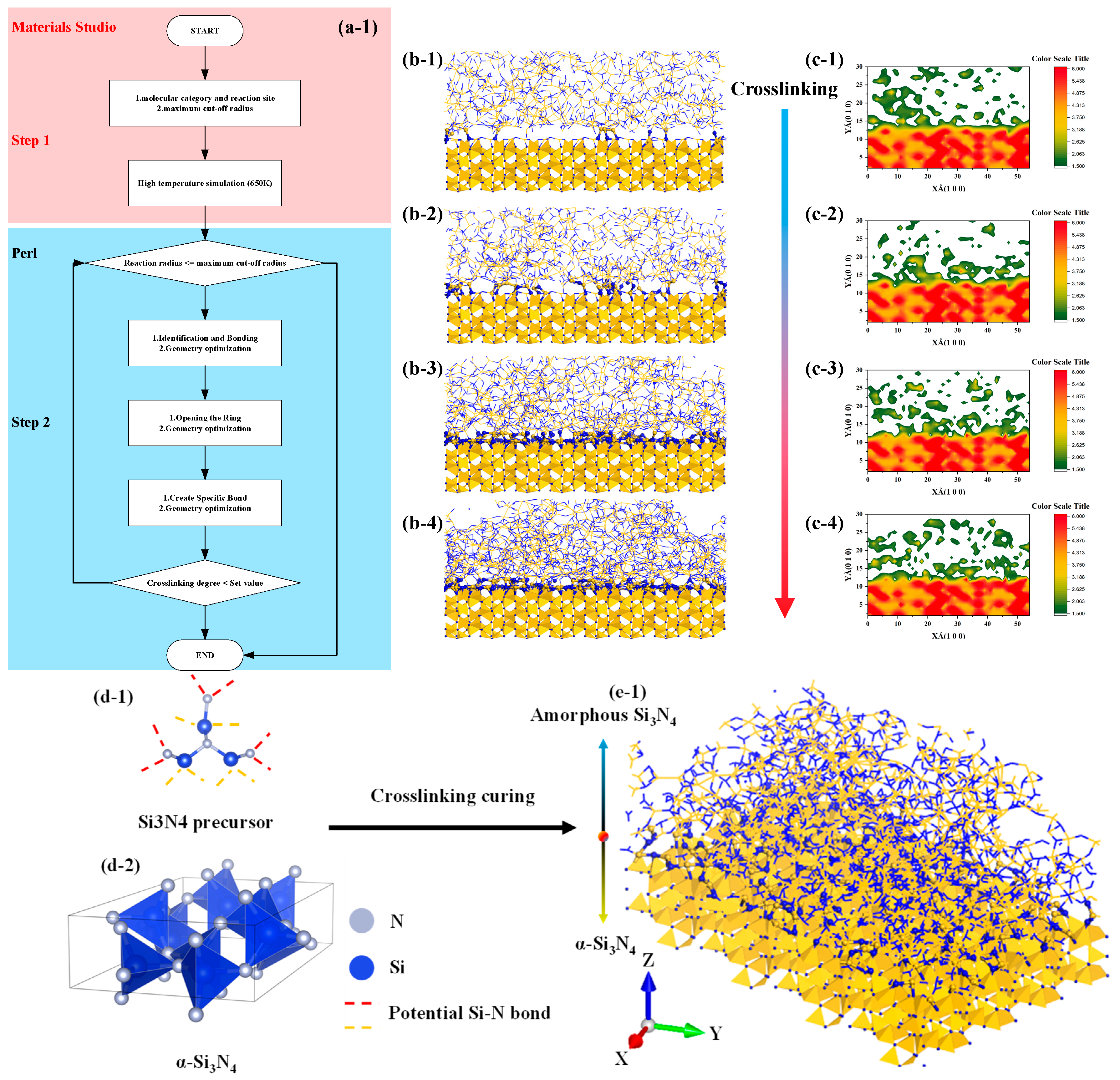

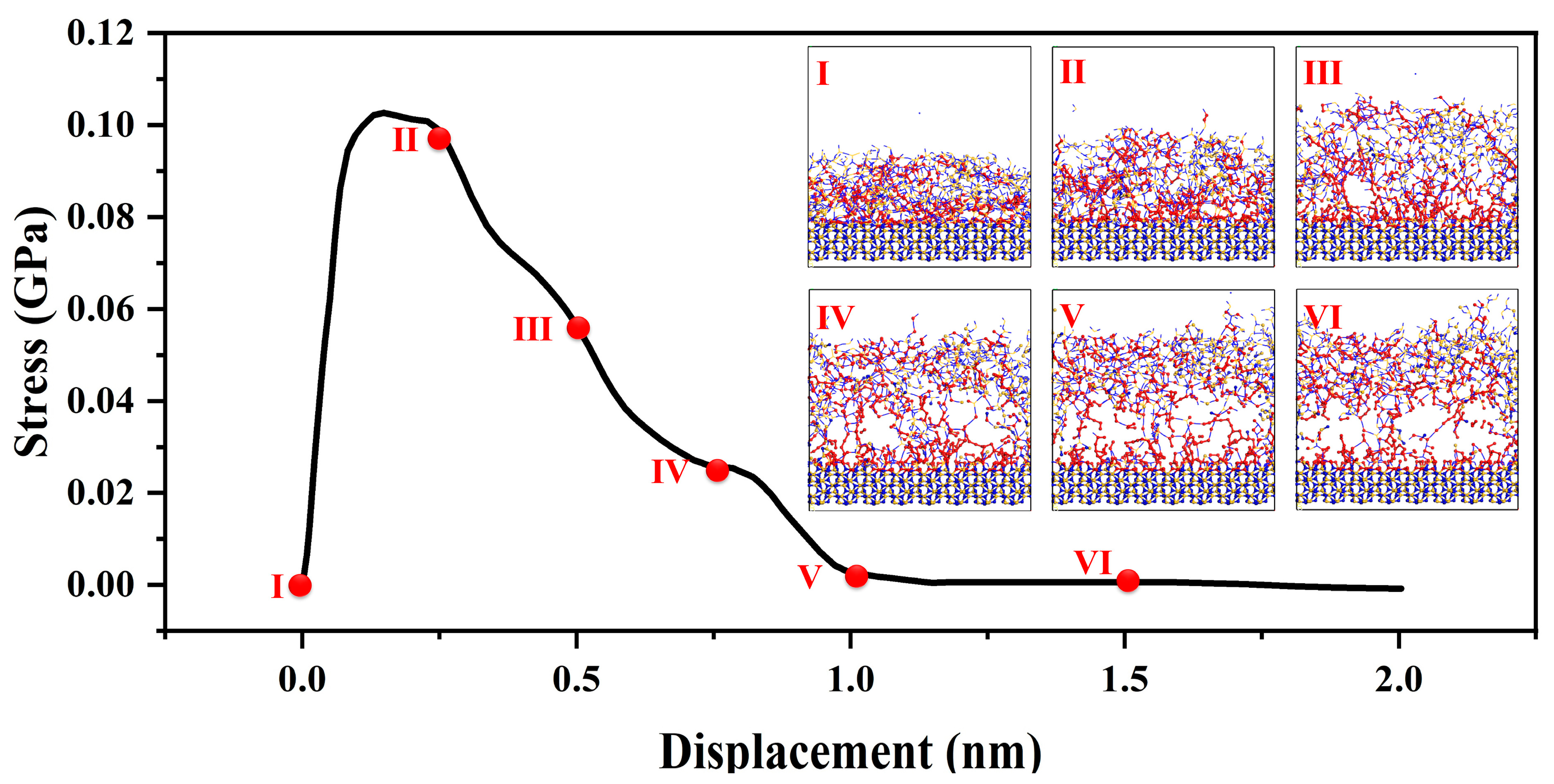

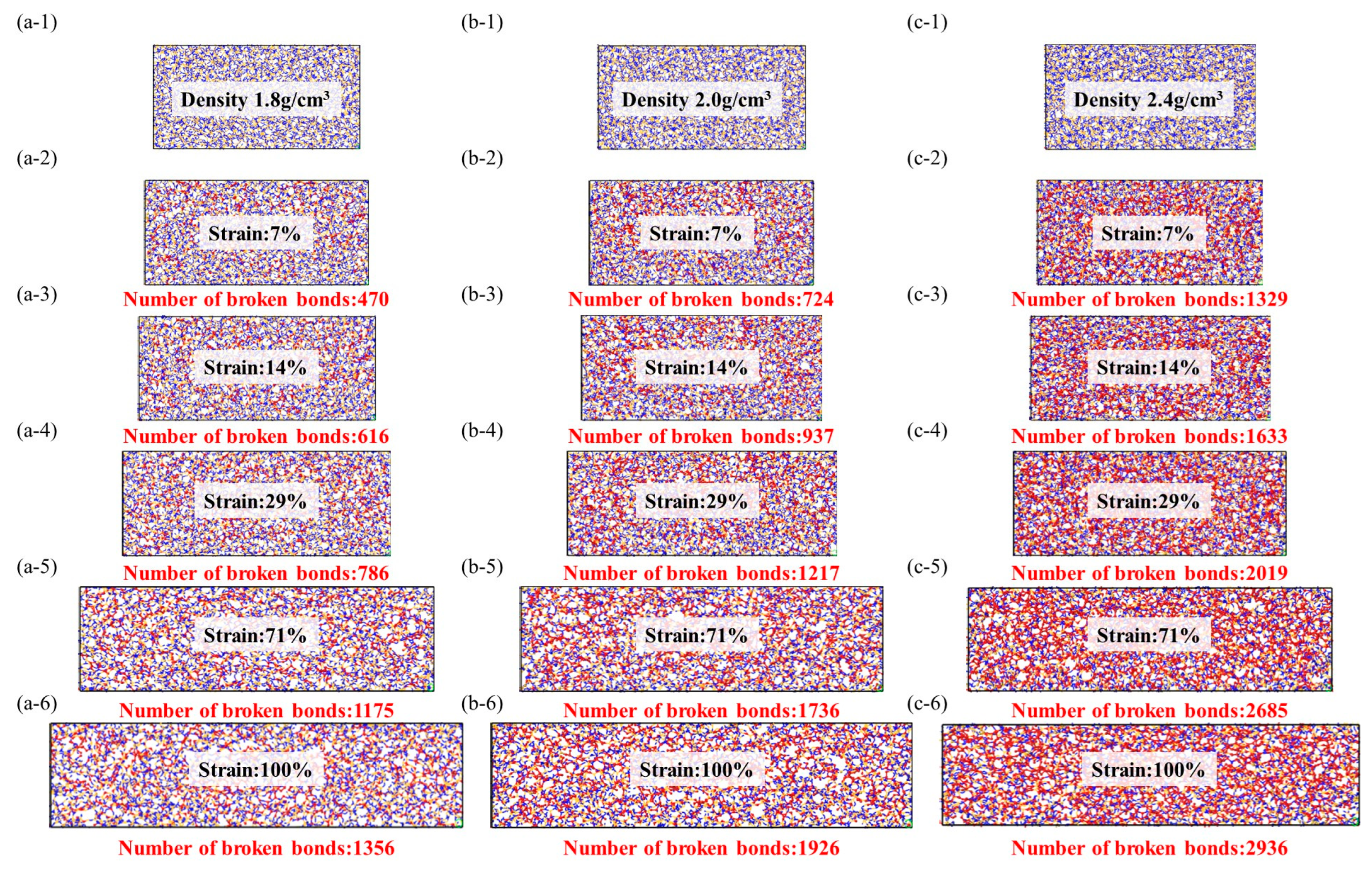

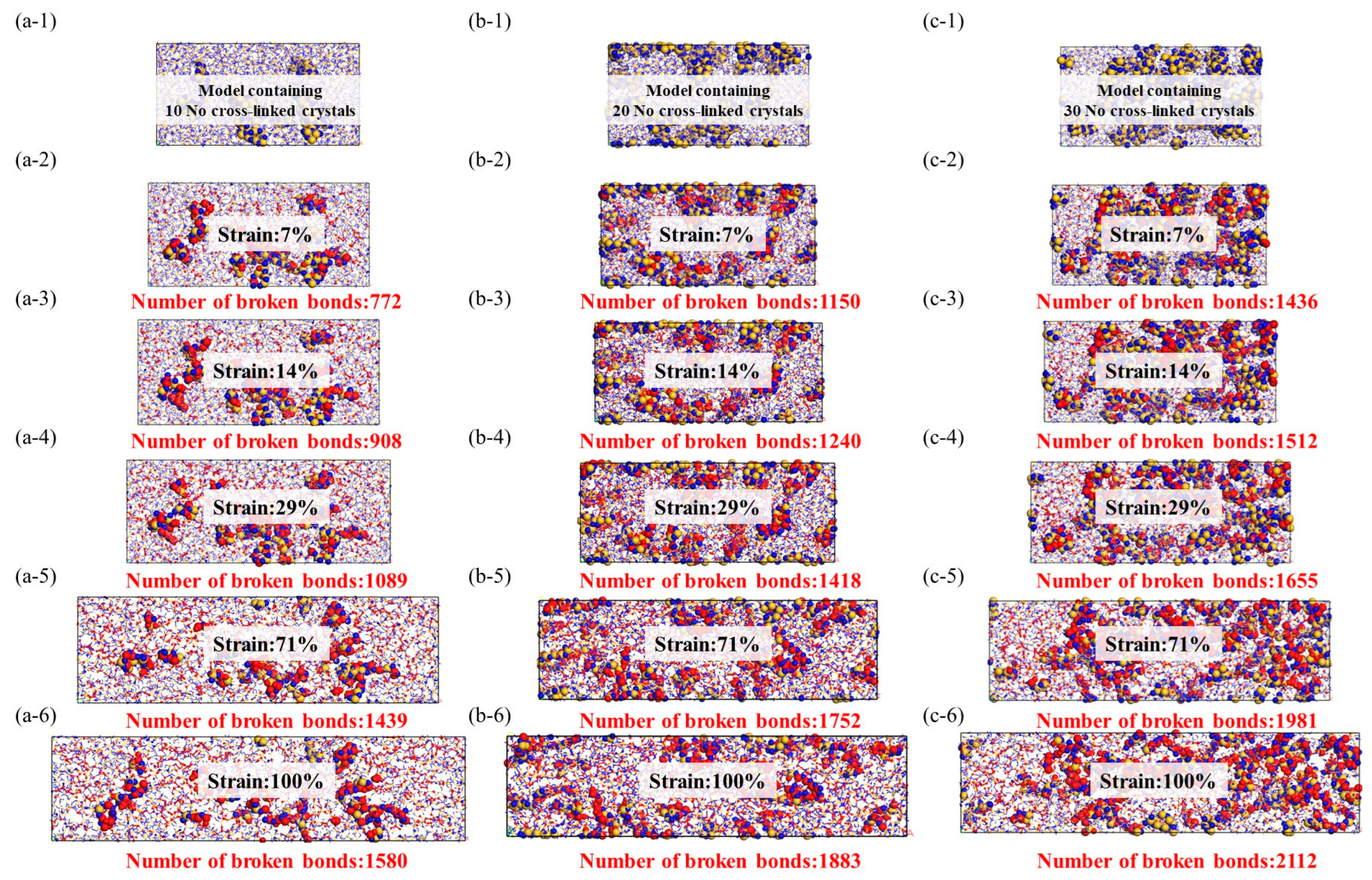
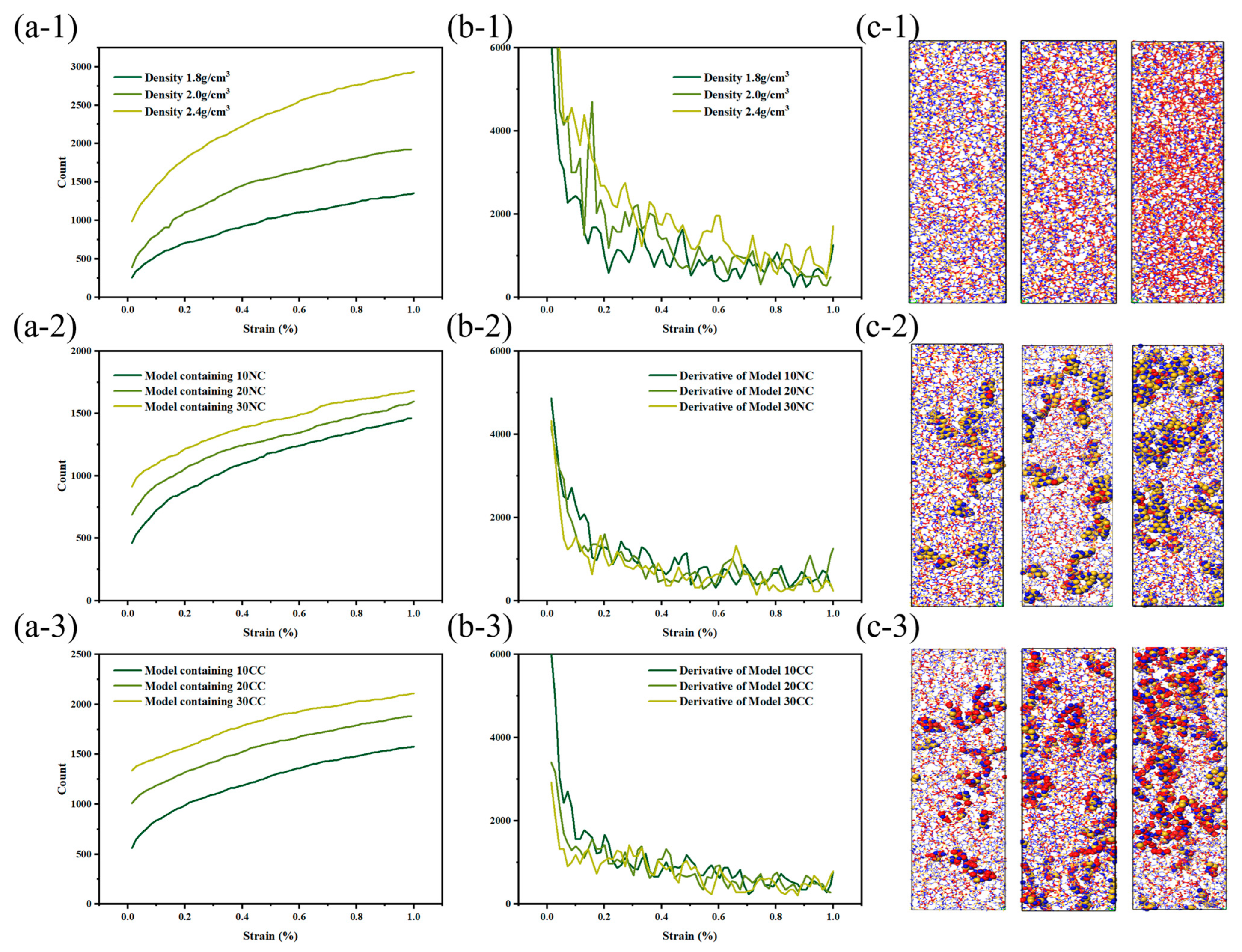
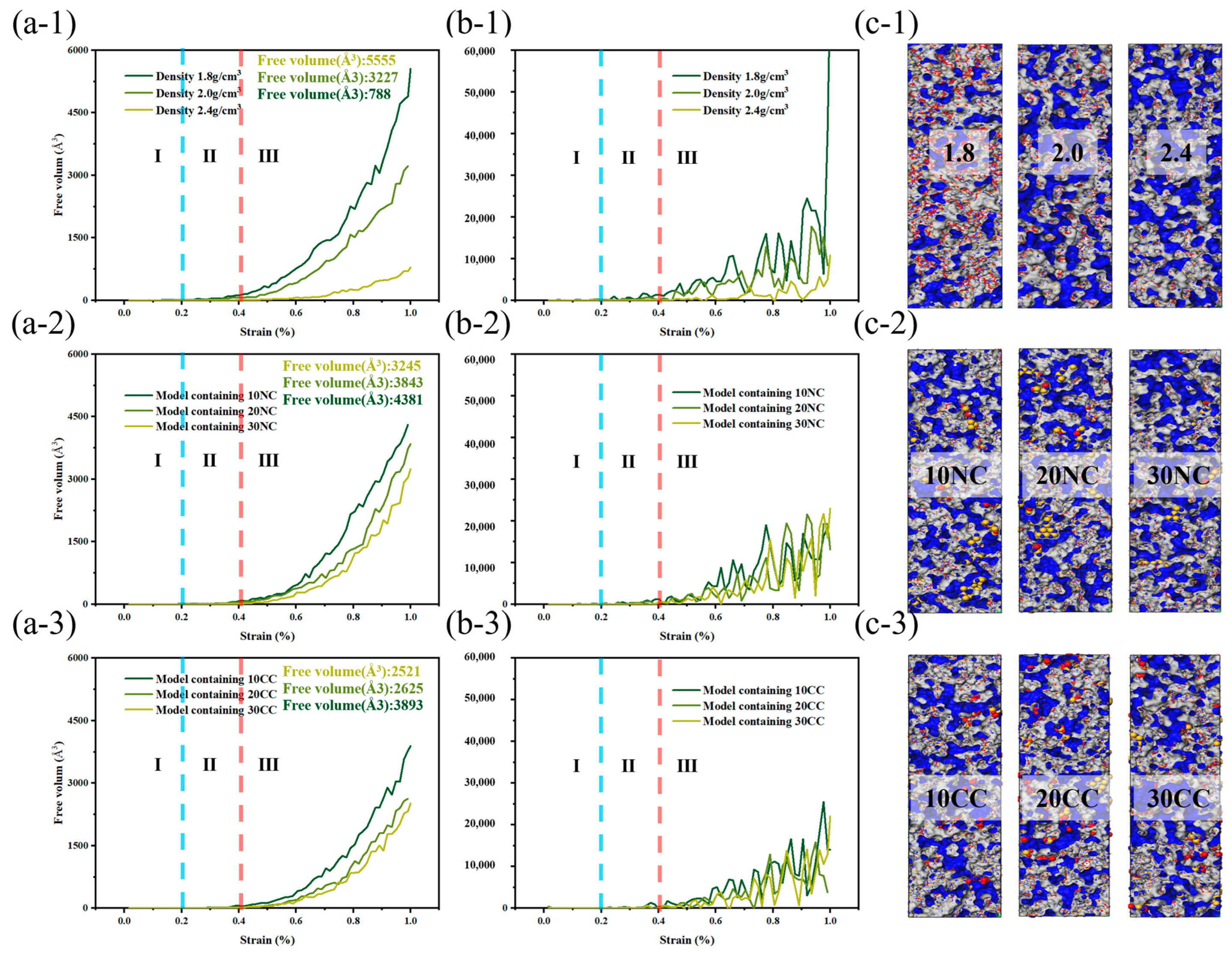
| Sample | N Content | Si Content | Length A(Å) | Length B(Å) | Length C(Å) |
|---|---|---|---|---|---|
| 1.8 | 3200 | 2400 | 71.6743 | 35.33 | 35.33 |
| 2 | 3200 | 2400 | 69.7651 | 34.3826 | 34.3826 |
| 2.4 | 3200 | 2400 | 65.7881 | 32.3944 | 32.3944 |
| 3205 | 2411 | 70.6743 | 35.3371 | 35.3371 | |
| 3260 | 2444 | 70.6743 | 35.3371 | 35.3371 | |
| 3245 | 2441 | 70.6743 | 35.3371 | 35.3371 | |
| 3205 | 2411 | 70.2571 | 35.0131 | 35.0131 | |
| 3260 | 2444 | 69.6074 | 34.8037 | 34.8037 | |
| 3245 | 2441 | 69.3168 | 34.6584 | 34.6584 |
Disclaimer/Publisher’s Note: The statements, opinions and data contained in all publications are solely those of the individual author(s) and contributor(s) and not of MDPI and/or the editor(s). MDPI and/or the editor(s) disclaim responsibility for any injury to people or property resulting from any ideas, methods, instructions or products referred to in the content. |
© 2023 by the authors. Licensee MDPI, Basel, Switzerland. This article is an open access article distributed under the terms and conditions of the Creative Commons Attribution (CC BY) license (https://creativecommons.org/licenses/by/4.0/).
Share and Cite
Hong, Y.; Zhu, Y.; Du, Y.; Che, Z.; Qu, G.; Li, Q.; Yuan, T.; Yang, W.; Dai, Z.; Han, W.; et al. Atomistic Construction of Silicon Nitride Ceramic Fiber Molecular Model and Investigation of Its Mechanical Properties Based on Molecular Dynamics Simulations. Materials 2023, 16, 6082. https://doi.org/10.3390/ma16186082
Hong Y, Zhu Y, Du Y, Che Z, Qu G, Li Q, Yuan T, Yang W, Dai Z, Han W, et al. Atomistic Construction of Silicon Nitride Ceramic Fiber Molecular Model and Investigation of Its Mechanical Properties Based on Molecular Dynamics Simulations. Materials. 2023; 16(18):6082. https://doi.org/10.3390/ma16186082
Chicago/Turabian StyleHong, Yiqiang, Yu Zhu, Youpei Du, Zhe Che, Guoxin Qu, Qiaosheng Li, Tingting Yuan, Wei Yang, Zhen Dai, Weijian Han, and et al. 2023. "Atomistic Construction of Silicon Nitride Ceramic Fiber Molecular Model and Investigation of Its Mechanical Properties Based on Molecular Dynamics Simulations" Materials 16, no. 18: 6082. https://doi.org/10.3390/ma16186082




